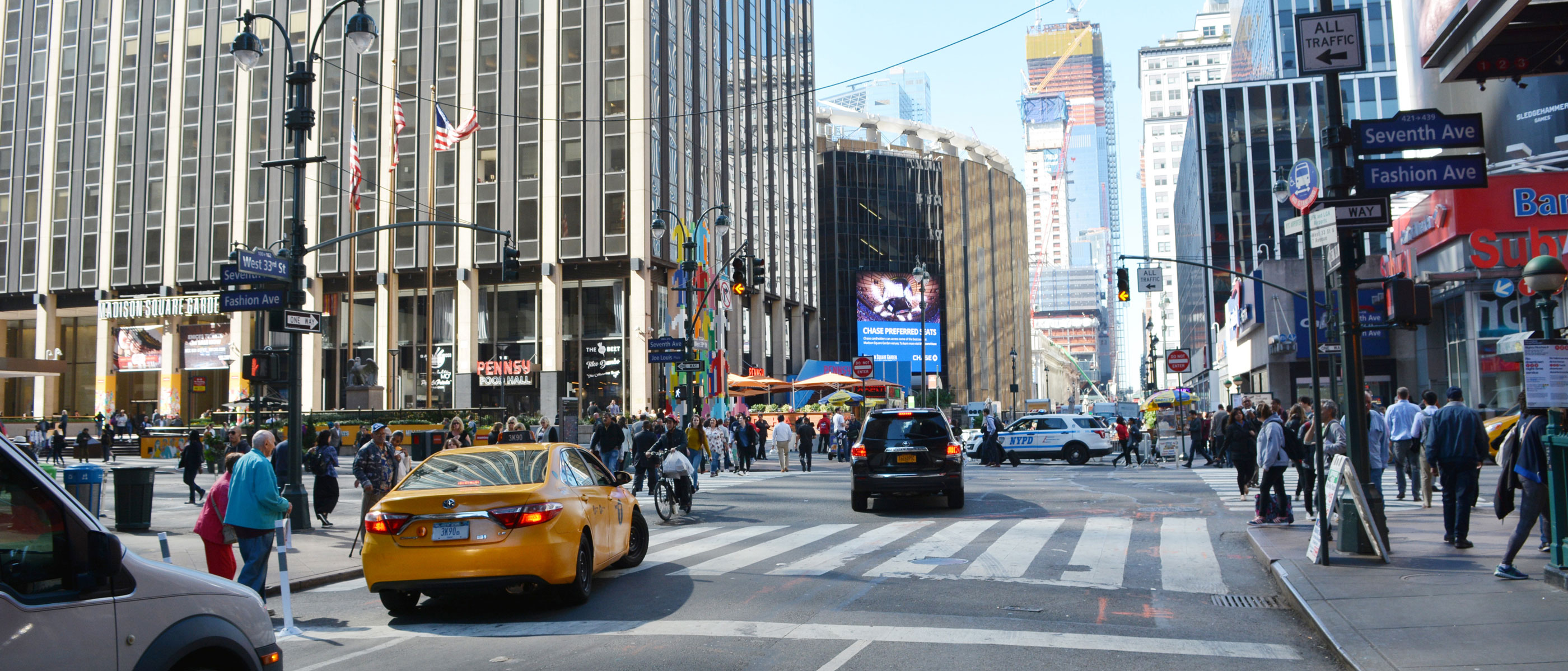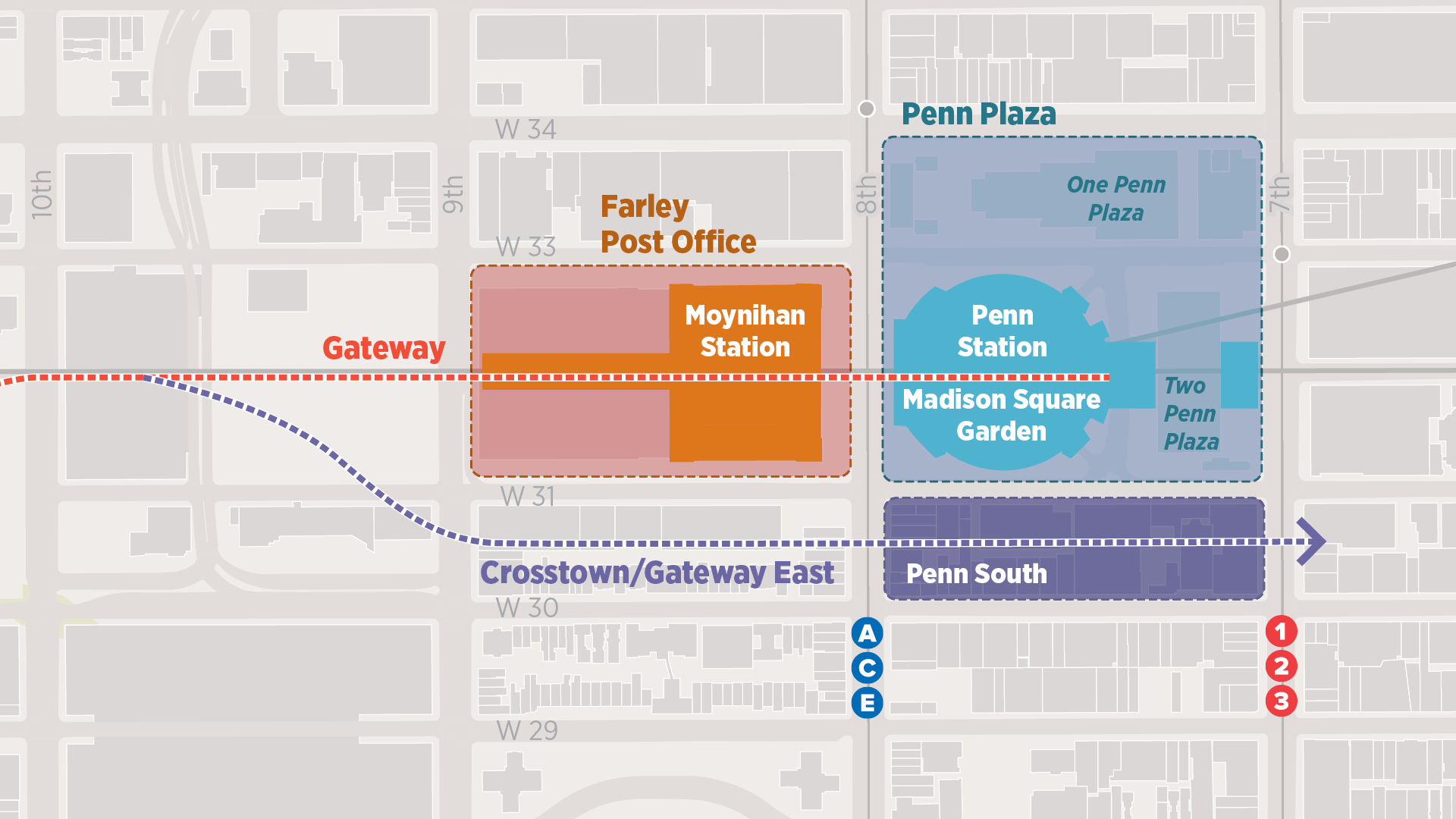
Long reviled for its cramped conditions and uninspiring design, Penn Station has become increasingly dysfunctional, as ridership into the station has nearly tripled in the last 25 years—a level of use never contemplated by the station’s architects. Concourses and platforms are narrow, and vertical circulation to the platforms is inadequate. The station lacks basic amenities like clear signage and comfortable waiting areas. With no natural daylight or other obvious visual markers, it’s easy to get lost. The station also has little to no presence from the street, and pedestrian conditions surrounding Penn are poor.
These problems will be further compounded in the future, as travel across the river increases in the coming decades. Work trips alone are projected to increase by 24 percent or more by 2040, depending on growth in all trans-Hudson travel and the amount of new rail service that connects to the station.
Unify the Penn Station complex into an inspiring gateway to New York
New York’s Penn Station is already a vast complex that extends over two square blocks and three underground levels. In 2020, a new train hall in the Farley Post Office building will be added to this complex, a project known as Moynihan Station. And the Gateway project, currently in the planning stages, will further extend Penn Station southward. These investments will expand the station’s footprint, relieving congestion and finally providing the opportunity to gut-renovate Penn Station.


Build Penn South for running service between New Jersey and Queens
As part of its Gateway proposal to build two new rail tunnels under the Hudson River, Amtrak has been studying extending Penn Station southward, down to 30th Street. The most recent proposal is for a new station, named Penn South, with five platforms and eight tracks, four of which could be extended to Queens in the future.
A far better scheme would be to build the station for through-running trains from the get-go. Because running trains straight through the station is so much more efficient than having trains terminate at Penn and turn around, fewer tracks and wider platforms could be built, while still accommodating up to 33 trains per hour.
In fact, Penn South as is currently proposed—with four stub-end tracks and five platforms of varying widths—would make it much more difficult to retrofit the station into through-running in the future. Instead, the Gateway tunnels to New Jersey should be extended to Sunnyside Yards, with two new tunnels and an intermediary station at Third Avenue.
To facilitate pedestrian circulation in Penn South, a new underground east-west concourse should be built, roughly between 30th and 31st Street, bookending the improved LIRR east-west concourse at the northern edge of the station.
Improve pedestrian conditions at the platform and track level
While a wholesale reconfiguration of platforms and tracks isn’t feasible in such a high-traffic station, some improvements should be made to increase station capacity, reduce congestion on the platforms, and enable through-running regional rail. These include:
- Widen select platforms in the center and southern end of Penn Station. This would result in the removal of a number of tracks.
- Replace escalators with stairs and elevators on the more narrow platforms to allow for greater vertical capacity.
- Simplify the station and improve vertical circulation by removing one of Penn Station’s underground levels and creating a more straightforward circulation scheme for the other level across the entire station complex.
- Remove as many old columns (from the original Penn Station) and other non-essential platform elements as possible to increase existing platform capacity.
- Install high-density signaling system in East River tunnels to increase their capacity and improve the reliability of the service.
The result of these investments and reconstruction would be a unified Penn Station complex with modern amenities and the capacity to serve a growing region. New York City and the region would finally have a station that reflects its status as a global economic hub and gateway to the metropolitan region. Commuters, intercity passengers, and visitors would enjoy the conveniences of a modern transportation hub, arriving in a station that is no longer a dreary and unpleasant experience but a place to linger and enjoy.
Paying for It
Much, if not all, of the costs for a new Penn Station should be paid for from the value of real estate development that will be created either directly, from air rights that are released, or indirectly, from increases in the value of existing buildings near the site that would benefit from proximity to a redesigned hub that attracts more travelers and becomes a destination itself. For example, moving Madison Square Garden could create more than two million square feet of additional development rights that could be used near the station.